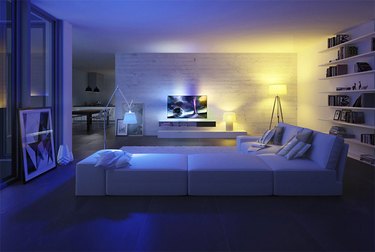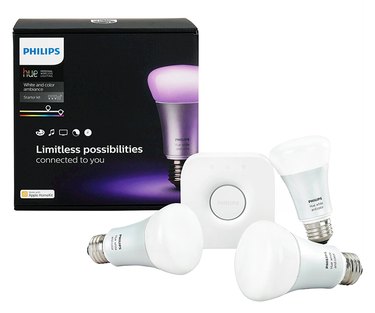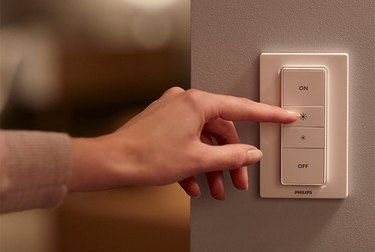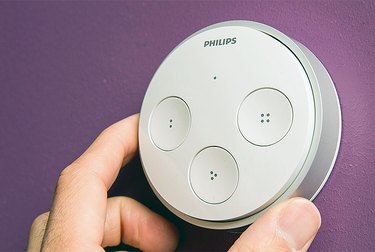Back in 2015, I accompanied a friend to the store as he picked up some Philips Hue smart bulbs. These LED lights screw into standard sockets and can be controlled wirelessly from your phone. There's more, of course: The lights are easily automated and can be controlled not just from your phone but via Alexa, Google Home, Apple HomeKit, and Siri, not to mention Philips's line of Hue light switches and even Internet of Home gadgets like Flic buttons.
After a few months of being impressed by his system, I decided that I should take a similar plunge.
Video of the Day
Video of the Day
I was hooked. I loved the elegant digital light switches; I appreciated the option to get color bulbs and the very affordable price point for white bulbs. There were even combo packs that offered additional savings.
Getting started with Hue
If you've never tried Philips Hue lights, you'll be happy to know that it's not very complicated to get started. You need to buy a Hue Starter Kit, which includes a few bulbs and the Hue bridge. Think of the bridge as a sort of control center for your Hue lights. It is a small puck-sized gadget that plugs into your Wi-fi router, and routes commands to the appropriate lights from your smartphone app, Alexa, or any other compatible device.
After the initial Starter Pack purchase, you can buy additional bulbs individually—the bridge is designed to connect to up to 50 bulbs. Remember that for later; it'll be important.
Why I installed 55 bulbs
Though I took the opportunity to dip my toes into the water of smart bulbs by installing a few Hue lights in my last apartment, last year I moved into a spacious new place and decided to illuminate it from top to bottom, side to side, with Philips Hue lights. My installation would be bigger than anyone else's I knew. Indeed, I suspect my installation may be bigger than even Philips expected anyone to attempt.
After lots (and lots) of Amazon deliveries, my new home has a total of 55 light bulbs, threaded into sockets in 17 distinct rooms, hallways, and closets.

Why? Well, I loved the promise of being able to individually address every bulb in my home. I appreciate being able to independently control and dim every bulb, and even to set the color of a few key bulbs.
It also allows for interesting automation options. Sure, my smart front door lock can turn lights on when I unlock it, but Hue lights allow for so much more. For example, Hue lights can be triggered using motion sensors—so my laundry closet illuminates when the doors are opened. The laundry bulbs stay on for a minute after the last motion is detected.
So I went all in on smart bulbs.
Hitting the limits of the bridge
Unfortunately, despite my system's potential, it's not perfect.
The most serious problem I've encountered is intermittent connectivity. HomeKit, for example, often reports that the bulbs are unreachable, and the Hue app itself does the same. Ask Siri to turn on lights in a particular room, and it's not uncommon to hear Siri say: "I'm having trouble communicating with the lights."
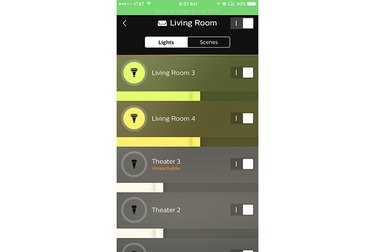
Philips has weighed in on this problem. The Hue technical support team theorizes that these connectivity problems are because I am exceeding the capacity of the bridge.
But here's where it gets interesting. As I mentioned earlier, officially, each bridge supports 50 bulbs—but that's not the end of the story. Online research shows that the bridge is actually capable of addressing 63 bulbs. Still, with 55 bulbs, I am definitely playing with fire.
Another theory: distances are taxing the ability of the bridge to stay connected to all the bulbs. But that rings a bit hollow. Since my place has just 1,200 square feet of space, it doesn't seem likely that distance is a factor, especially since some of the closest bulbs are the ones that often go offline.
Surprisingly, the Hue light switches actually work without a hitch as much as 90 percent of the time, even when HomeKit and the Hue app cannot reach the bulbs. If not for this, the system would be utterly useless much of the time.
There’s a limit to light switches, too
When you install close to five dozen smart bulbs in your home, you push the limits of what Philips envisioned for their smart lighting system.
In addition to the 50 (or is it 63) bulb limit for the bridge, there appears to be a severe limit on the number of dimmer and tap switches allowed on the network as well, and the real numbers don't seem to agree with what Philips contends in their specifications.
Officially, Philips says you can connect 12 dimmer switches or 24 tap switches to your Hue bridge. Why 12 and 24? Why not 24 of either? Well, dimmer switches are more complex, and therefore require more memory in the bridge. So there's room for more tap switches on the bridge than dimmers.
That's great, but I began running into problems after adding only the 7th dimmer switch. This prompted me to sell the dimmer switches and change to using just tap switches.
With 15 tap switches installed, I (the tinkerer I am) learned that I could further configure each button with a third party iPhone app. For example, I can make each button perform multiple functions, such as on, off, on dim, party scene, and so on. But every additional task I gave to each button consumes additional memory on the bridge, and I quickly ran out of capacity.
The moral is that the wonderfully elegant Hue switches aren't like mechanical switches; programming them takes unpredictable amounts of memory, and more ambitious setups can cause problems.
The perils of a second bridge
There's a seemingly obvious solution to all of these problems: Add a second Hue bridge to my home. 55 lights and nearly two dozen switches might exhaust a single bridge, but it should be child's play for two bridges, right?
Not so fast. While the bulbs themselves are HomeKit compatible, the switches are not. And that means that switches only work with the lights assigned to whichever bridge they are connected to. I currently have several buttons that are programmed to control all the lights in my home with the press of a single button. That's convenient, but spread across two bridges, that will no longer work.
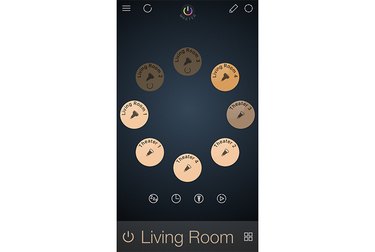
The compromise? Assign bridges, lights, and switches geographically around the house. I could use the second bridge for my two bedrooms and bathrooms, for example. This way, each bedroom could still control its associated bathroom lights. But since the tap switch next to my bed will be unable to turn lights off in other rooms (since they're on a different bridge), I will be required to use HomeKit to operate them.
Looking forward
The bottom line is that while Philips Hue (and similar smart wireless) lighting systems are an amazing revelation, giving you the ability to control lights in your home in ways you never would have previously imagined, they still have some room to grow. If your needs are modest, jump in with both feet. But as you expand to the system's design limits, you'll be right there with me, waiting for Philips to improve the system.
